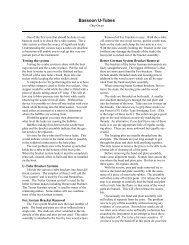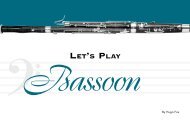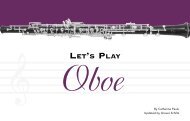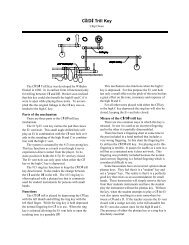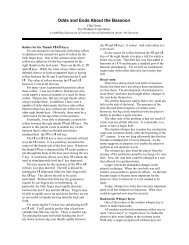English Horn playing guide pdf - Fox Products
English Horn playing guide pdf - Fox Products
English Horn playing guide pdf - Fox Products
Create successful ePaper yourself
Turn your PDF publications into a flip-book with our unique Google optimized e-Paper software.
LET’S PLAY<br />
<strong>English</strong> <strong>Horn</strong><br />
By Grover Schiltz
2<br />
Grover Schiltz<br />
In 1959, Grover Schiltz joined the Chicago Symphony Orchestra as<br />
assistant principal oboe, moving to <strong>English</strong> horn in 1964. In prior<br />
years he played in the Lyric Opera of Chicago, the Grant Park<br />
Symphony and toured with the Boston Pops. He also played with the<br />
St. Louis Sinfonietta and spent three years as a principal oboist of the<br />
Kansas City Philharmonic.<br />
Schiltz is active in chamber music ensembles in the Chicago area<br />
including the Chicago Symphony Winds. He has taught oboe and<br />
baroque performance practice at Northwestern University and serves<br />
on the faculty at Roosevelt University and the University of Illinois<br />
Circle Campus. He currently teaches oboe and <strong>English</strong> horn privately.
INTRODUCTION:<br />
This booklet is intended to introduce the <strong>English</strong> horn to students and teachers who<br />
may already have some knowledge of the oboe. Many of the techniques and skills used<br />
to play the oboe are similar on the <strong>English</strong> horn, so it may be useful to revisit them.<br />
Anyone with more than a casual interest in music is acquainted with the beautiful and<br />
unique sound of the <strong>English</strong> horn. Its alto quality enriches the tonal palette of any<br />
ensemble. It has one of the loveliest solo repertoires in the wind literature. It gives a<br />
distinctive stamp to Dvorak’s “New World Symphony”, Berlioz’ “Roman Carnival<br />
Overture”, and Rossini’s “William Tell Overture”, just to name a few compositions firmly<br />
fixed in the literature. It is equally at home in the Orchestra or the Wind Ensemble.<br />
Since the <strong>English</strong> horn is in F, it will sound a 1/5 below the written pitch. Every oboist<br />
should have the opportunity to play the <strong>English</strong> horn and learn some of these famous<br />
solos. In many smaller ensembles, the second oboist is called upon to double on both<br />
oboe and <strong>English</strong> horn. A player who can do so is just that much more valuable to the<br />
ensemble.<br />
3
INDEX<br />
Introduction........................................................................3<br />
Starting the Student on <strong>English</strong> <strong>Horn</strong> ...............................6<br />
Choosing Equipment .........................................................7<br />
Assembly and Care of the <strong>English</strong> <strong>Horn</strong> ......................8-10<br />
Embouchure .....................................................................11<br />
The Commercial Reed .....................................................12<br />
Adjusting the Commercial <strong>English</strong> <strong>Horn</strong> Reed................13<br />
Pitch of the Reed .............................................................14<br />
Tips for Solving Specific Reed Problems.........................15<br />
<strong>English</strong> <strong>Horn</strong> Fingering Chart .....................................16-21<br />
Methods and Tutors.........................................................22<br />
Solo and Ensemble Material............................................22<br />
Help Sites .........................................................................22<br />
5
6<br />
STARTING THE STUDENT ON THE ENGLISH HORN<br />
Usually, the first exposure to the <strong>English</strong> horn will be after the oboe has been played for<br />
some time. Most elementary schools have neither the budget nor the advanced scoring in<br />
the music being performed to require an <strong>English</strong> horn. However, from the eighth grade<br />
onward, one may encounter material in the repertoire calling for the use of the <strong>English</strong><br />
horn. Also, students in larger metropolitan areas may have access to all-city bands or<br />
orchestras or honors groups. The oboe is the basic instrument, and with a background of<br />
some study, the transfer to the <strong>English</strong> horn can be quickly made.<br />
Since the instrument is larger and heavier, many people find that a neck strap is advisable.<br />
A saxophone type adjustable strap with a wide collar works very well. It may be found<br />
that a stout rubber band or other elastic coupling makes a good link between the hook<br />
of the strap and the ring on the thumb rest. This supports the weight of the instrument<br />
without giving up control of the position of the reed in the embouchure. Since long sessions<br />
with a heavy instrument can result in tendonitis, this can be an important factor.
CHOOSING EQUIPMENT<br />
The difficulty of the repertoire can be a factor in choosing the model of<br />
<strong>English</strong> horn needed. However, an instrument of any level should have a<br />
free, even response over the range, an even tone quality and a good scale.<br />
Many <strong>English</strong> horns in the past have had problems with an unstable third<br />
space C which would drop in pitch on diminuendo. This fault has been<br />
largely eliminated by the development of better bocals. Another problem<br />
has been the tendency of the instrument to develop a “gurgle” upon<br />
diminuendo on low E or E♭. A third trouble spot to check lies in the upper<br />
register on high A♭. It should be well up in pitch and not have a “sagging”<br />
quality. Top of the line instruments will have a full mechanism, including a<br />
3rd octave key for pitches above E♭ in the third octave.<br />
7
8<br />
ASSEMBLY AND CARE OF THE ENGLISH HORN<br />
The <strong>English</strong> horn is assembled in the same manner as the<br />
oboe. Of great importance in the process is the careful<br />
and proper alignment of the bridging keys between the<br />
upper and lower joints. The use of a bit of cork grease on<br />
the cork joints is good, since it does away with the tendency<br />
to “force” the fit of the joints. If the joint is unstable,<br />
there may be too much cork grease, which can be<br />
removed with a tissue.<br />
There are two bridging keys between the upper and lower<br />
joint. On one side is the trill key bridge for the C-D trill.<br />
On the other side is the bridge for the fingering combination<br />
for C and B♭. Assembly of the upper and lower joints<br />
is easily accomplished by observing from the back of the<br />
instrument, the better to see the alignment of the bridging<br />
keys. The bell joint presents no problem, since there is<br />
only one bridge.<br />
BELL<br />
The <strong>English</strong> horn also uses a bocal, which extends from the<br />
top of the instrument, curving toward the player. The reed<br />
tube slips over the top of the bocal, completing the<br />
assembly. Some players find it very useful to use a piece of<br />
thin rubber or plastic tubing as an airtight bond at the<br />
juncture of the reed tube and the bocal. A short piece of<br />
aquarium tubing works quite well. In addition to making a<br />
good seal, this prevents the reed from slipping off the<br />
bocal during performance.<br />
■ Always soak the reed while putting the <strong>English</strong> horn<br />
together. Dip the reed in water, shake off the excess<br />
water and let it stand for a few minutes before <strong>playing</strong><br />
on it. If left standing in water, the reed becomes quite<br />
open and difficult to manage. If water is not available,<br />
the reed can be moistened with saliva.<br />
LOWER JOINT
■ Cradle the upper joint in the left hand. Place the right<br />
thumb on the E key of the second joint and carefully<br />
maneuver the two parts together, gently pushing and<br />
turning in a clockwise direction until the bridge mechanism<br />
is properly aligned. Be careful not to bump the<br />
“arm” above the F# key. Do not hold onto the C, C#,<br />
and E♭ spatula cluster.<br />
■ Cradle the thumb rest in the left hand. This holds it up<br />
and out of the way while pushing and twisting the bell<br />
into the lower joint. (Left-handed people should<br />
reverse hands in the assembly procedures).<br />
■ The reed tube slips over the top of the bocal.<br />
■ Wooden instruments need care! Extremes of temperature<br />
can be deadly. Never play an instrument when it is<br />
UPPER JOINT BOCAL<br />
cold. Let it come to room temperature or warm it under a<br />
coat or sweater next to your body. The most crack-prone<br />
area of an oboe or <strong>English</strong> horn is the area between the<br />
trill tone holes in the upper joint. Often a tiny crack can<br />
develop almost unseen, which can seriously hamper an<br />
instrument’s <strong>playing</strong> ability. A good test for air tightness is<br />
to cover all the tone holes in the top joint and insert a rubber<br />
stopper in the bottom of the upper joint. Try to create<br />
a vacuum by sucking out the air from the top of the joint.<br />
If it won’t hold a vacuum, you may need to see a repairperson<br />
to check for a crack. The newer plastic and composite<br />
instruments do away with that particular problem.<br />
■ The instrument should be swabbed out after each use with<br />
a silk swab (taking care not to force the swab through).<br />
Occasionally, carefully oil a wooden instrument bore with<br />
bore oil.<br />
9
10<br />
ASSEMBLY AND CARE OF THE ENGLISH HORN (CONTINUED)<br />
THE BOCAL<br />
The bocal is extremely influential in the sound and tuning<br />
of the <strong>English</strong> horn. Bocals are available in varying lengths,<br />
with #1 being the shortest, and #3 being the lowest in<br />
pitch. Individual bocals can vary in tone color, response,<br />
and dynamic range, so it is important that the instrument<br />
you choose has a well made bocal to complement it. Treat<br />
the bocal with care, so as not to bend or dent it, and clean<br />
it out periodically with warm water, a mild detergent and a<br />
pipe cleaner.<br />
ADJUSTMENTS<br />
Unless you have had some experience with adjusting<br />
woodwinds, it is best to let an experienced repairperson<br />
handle adjustments. Often, a small problem can become a<br />
big one with a screwdriver in untrained hands.<br />
REEDS<br />
The <strong>English</strong> horn reed differs from the oboe reed in two<br />
ways. First, the reed is not inserted into the body of the<br />
instrument, but is instead fit over the end of the bocal.<br />
Second, the reed usually has a thin brass wire wrapped<br />
twice around the reed about 6mm above the winding.<br />
The wire is not essential, but it serves to stabilize the size<br />
of the opening. The length of the reed and staple together<br />
is from 53 to 56mm. The material in the oboe manual pertaining<br />
to the adjustment of reeds is equally applicable to<br />
<strong>English</strong> horn reeds. Only the proportions are somewhat<br />
larger. For anyone who wishes to go into reed making in<br />
greater detail, a fine reference is David Weber’s book<br />
“The Reed Maker’s Manual.” An accompanying videocassette<br />
is available. Another fine text is “The Oboe Reed<br />
Book” by Jay Light.<br />
REED CASES<br />
It is important to have a reed case that supports the reed<br />
in such a way that nothing can damage the delicate tip. It<br />
should also allow for air circulation around the reed to<br />
keep it dry when not in use. There are commercial reed<br />
cases available or cases can be made by the student. Do<br />
not use the plastic tubes in which some commercial reeds<br />
are packaged. They do not permit thorough drying of the<br />
reed between uses.
Photo by Bev Schiltz<br />
EMBOUCHURE<br />
Rest the reed on the lower<br />
lip so that the tip lies midway<br />
on the lip. As a breath is<br />
taken, the lower lip is rolled<br />
in over the lower teeth. The<br />
upper lip goes over the<br />
upper teeth providing a<br />
double lip embouchure.<br />
Students transferring from<br />
clarinet to <strong>English</strong> horn frequently<br />
have difficulty at first<br />
tucking in the upper lip.<br />
The reed should be at a position where just the tip is in the<br />
mouth and about half of the cane is exposed on the outside.<br />
Too much reed in the mouth (down to the winding) will<br />
result in harsher tone and sharper pitch. The teeth are<br />
spaced so that the lip rests on them. There is plenty of<br />
room for the reed to be held loosely and not clenched<br />
tightly. The lips act as a cushion for the reed and should<br />
be thought of as rounded and soft and supple like forming<br />
the syllable “O” and not “E”. Avoid the “smile” or<br />
“stretched rubber band” embouchure.<br />
Control is achieved by very subtle changes in the tension<br />
of the lips of the reed. With the proper embouchure<br />
formed, very little, if any, of the red part of the lip will be<br />
visible. When <strong>playing</strong> the <strong>English</strong> horn, the instrument<br />
should be held so that if forms a 45° angle with the body.<br />
Do not hold the instrument too closely to the body or<br />
straight out like a trumpet. Good posture is important<br />
whether standing or sitting. A straight back allows full air<br />
capacity to the lungs for<br />
proper breath support. Deep<br />
breathing and the use of the<br />
abdominal muscles below the<br />
diaphragm is the basis for<br />
good tone quality and control.<br />
A beginner may find it<br />
advantageous to produce a<br />
sound on the reed before trying<br />
it in the instrument.<br />
Photo by Bev Schiltz<br />
11
12<br />
THE COMMERCIAL REED<br />
Serious students of the <strong>English</strong> horn will begin learning the<br />
reed making process as soon as they are old enough and<br />
careful enough to manage the necessary tools. If reeds are<br />
not available from a private teacher or local player, attempt<br />
to purchase the American or “long scrape” reed.<br />
While the French scrape is more easily obtained, there are a<br />
variety of “long scrape” style reeds available. Almost all professional<br />
oboists in the United States now use some variation of<br />
the “long scrape”. The thinner, shorter tip may be more fragile,<br />
but the pleasant tone quality they produce will make the extra<br />
care the reed takes very worthwhile.<br />
The grading of <strong>English</strong> horn reeds as soft, medium or hard has<br />
little relationship to the fact and varies from one manufacturer<br />
to another. Many commercial reeds are too soft. Try reeds from<br />
several manufacturers to determine which is most consistent<br />
and best suited to your instrument and style of <strong>playing</strong>.<br />
There should be some “resistance” in the reed to enable the<br />
player to play with good breath support.<br />
FRENCH or<br />
“SHORT SCRAPE”<br />
AMERICAN or<br />
“LONG SCRAPE”<br />
Tip<br />
Heart<br />
Backbone<br />
Shoulders
ADJUSTING THE COMMERCIAL ENGLISH HORN REED<br />
It is important to know the techniques used in adjusting<br />
commercial reeds. The following four pieces of simple equipment<br />
are essential for students to begin adjusting reeds:<br />
A SHARP KNIFE:<br />
A sharp knife for scraping the reed is the most important tool.<br />
It can be purchased from reed making suppliers or handmade.<br />
The blade may be either hollow ground or with a beveled<br />
edge. A sharpening stone and honing oil are also important. It<br />
is necessary to keep the knife-edge sharp and free from nicks.<br />
PLAQUE:<br />
The plaque is a small piece of metal that is inserted<br />
between the blades of the reed while scraping.<br />
It supports the blades. Plaques are available<br />
commercially.<br />
CUTTING BLOCK:<br />
The cutting block is used to support the tip of the reed while<br />
clipping it with the knife. They are available commercially or<br />
can be handmade from a piece of hardwood<br />
that has been smoothly sanded to<br />
eliminate all grooves.<br />
FISHSKIN:<br />
Commercially, fishskin is called “Goldbeaters Skin”. It is<br />
used to seal the sides of the reed without adding weight<br />
to the reed. Added weight will inhibit the reed’s vibrating<br />
qualities. A reed must not leak air below the portion<br />
that is in the mouth. Cut a strip of fishskin about 1 1 ⁄2”<br />
by 1/4”. While slightly moistened, pull the strip of fishskin<br />
tightly around the reed, starting midway or less up<br />
the reed. Pull tightly around the reed spiraling downward<br />
until it overlaps the top of the winding thread. Do<br />
not over moisten. If the fishskin is too wet it will shrivel<br />
up and disappear. A little practice is necessary to handle<br />
it correctly.<br />
Players also are beginning to use a very thin plumber’s<br />
tape, available in hardware stores. It is available in dispensers<br />
like adhesive tape. It has the advantage of<br />
being self-adhesive. It also stays in place under moist<br />
conditions.<br />
13
14<br />
PITCH OF THE REED<br />
Pitch of the reed is determined by:<br />
1. LENGTH of the reed – The reed should play the instrument<br />
in tune when it is placed over the bocal to the<br />
stopping point. Most <strong>English</strong> horn reeds are from 53<br />
to 56mm in length.<br />
2. OPENING of the reed is equally important. Reed<br />
openings can be easily adjusted.<br />
A reed that is too open will usually play flat. A reed which<br />
has a too-closed opening will tend to be sharper in pitch.<br />
Old and worn-out reeds become more closed and become<br />
too sharp in pitch.<br />
The opening of the reed is an important factor for other<br />
reasons as well. If a reed is too open, players are forced<br />
to “bite”, whether they are aware of it or not, and the<br />
embouchure will quickly fatigue. If the reed is too closed, it<br />
is impossible to blow into it with adequate breath support.<br />
Too open<br />
Too closed<br />
Correct opening
TIPS FOR SOLVING SPECIFIC REED PROBLEMS:<br />
A. IF THE REED IS TOO SHARP –<br />
1. The reed may be too short. Scrape a little more wood from<br />
the back of the reed.<br />
2. The reed opening is too small. The wire can be tightened<br />
to improve the size of the opening.<br />
3. The bocal can be pulled out of the instrument a small<br />
amount before it adversely affects the intonation of the<br />
instrument.<br />
B. IF REED IS TOO FLAT –<br />
1. Check to see if the reed is split. A cracked/split reed is<br />
often flat.<br />
2. The reed is too long. Cut off the reed about 1mm or less.<br />
Thin just the end of the reed tip to make it respond. If it is<br />
still flat, repeat this procedure a few times. It is sometimes<br />
necessary to cut off the entire tip and scrape a new one in<br />
order to make the reed respond.<br />
3. Cane is too wide. Making the reed shorter might compensate.<br />
4. Opening is too large. If it seems to respond well, try holding<br />
the tip of the well-soaked reed closed for several seconds<br />
between the fingers. This will weaken the reed slightly.<br />
Repeat this procedure a few times. If unsuccessful, it<br />
will be necessary to scrape the shoulders a slight amount.<br />
C. THE REED IS STIFF, STUFFY OR SLOW<br />
TO RESPOND –<br />
1. Make the very end of the reed tip thinner.<br />
2. Remove a little wood from behind the reed tip.<br />
3. If it appears that the back is still too thick, scrape a bit<br />
more off, particularly if the low notes do not respond.<br />
Be careful not to remove the “backbone” or the reed<br />
will become flat, or the octaves will be flat, forcing the<br />
player to “bite”.<br />
D. THE REED IS TOO FREE AND EASY TO BLOW –<br />
1. Too much wood has already been taken out of the reed<br />
or the tip may be too thin. Clip the tip and readjust.<br />
2. Proceed as in B-2 above. It is possible that the reed<br />
will become too short and sharp while doing this. If<br />
this happens, discard the reed and try another. You<br />
can always take more wood out of a reed but obviously<br />
it is impossible to put it back.<br />
15
16<br />
ENGLISH HORN<br />
FINGERING CHART<br />
The following is a basic fingering chart that is used for<br />
tuning <strong>Fox</strong> and Renard oboes. The <strong>English</strong> horn has<br />
approximately a 2 1 ⁄2 octave range and very few alternate<br />
fingerings. The one exception is “Forked F”. Many students<br />
brought up in a band program acquire the habit of<br />
using only the “Forked F” fingering. “Forked F” is an<br />
alternate fingering to be used when necessary: when “F”<br />
occurs before or after E♭, D, C , low C, low B or B♭. The<br />
basic fingering for “F” (or the left “F” key on those instruments<br />
that have it) produces better intonation and noticeably<br />
better tone quality.<br />
LEFT<br />
HAND<br />
RIGHT<br />
HAND<br />
Left Thumb<br />
(Located under instrument)<br />
Cradle of 1st Finger<br />
1st Finger<br />
2nd Finger<br />
3rd Finger<br />
4th Finger<br />
1st Finger<br />
2nd Finger<br />
3rd Finger<br />
4th Finger
B ♮ C C – D ♭ D E♭ – D<br />
<br />
♮ ♭<br />
1. Forked “F” (See page 16)<br />
2. Left-handed F<br />
OR*<br />
E<br />
<br />
F 1. 2.<br />
<br />
* Use left-hand E♭ key if before or after D♭ (C ).<br />
17
18<br />
F – G ♭ G<br />
A ♭ – G A B ♭ – A B♮<br />
<br />
♭ ♭ ♮ <br />
OR<br />
C
C – D ♭ D E ♭ – D <br />
E F 1. 2.<br />
<br />
<br />
<br />
♭<br />
<br />
OR*<br />
1. Forked “F” (See page 16) ** Use left-hand E♭ key if before or after D♭ (C ).<br />
2. Left-handed F ** E♭ Key may be used with Forked “F” for stability on some instruments.<br />
**<br />
F <br />
<br />
19
20<br />
<br />
G C<br />
<br />
G – A ♭ A B ♭ – A <br />
C – D ♭<br />
♭<br />
♮ B ♮<br />
* * * *<br />
<br />
OR OR<br />
* Left Thumb Key may be left down to ease facility on A, B♭ ,B♮ and C.
E F<br />
G<br />
♭<br />
<br />
D E♭ D F<br />
OR* OR**<br />
** Use before or after high E♭ (D ).<br />
** Use before or after E♭ (D ).<br />
21
22<br />
METHODS AND TUTORS<br />
Since the fingerings, basic <strong>playing</strong> techniques and<br />
embouchure are so similar, any good oboe method is<br />
equally applicable to the <strong>English</strong> horn. Rubank and Belwin,<br />
among others, publish beginners books. After that,<br />
Kenneth Gekeler and David Hite have published some useful<br />
material. From there to the Barret “Standard Oboe<br />
Tutor” and the Ferling “48 Etudes.”<br />
SOLO AND ENSEMBLE MATERIAL<br />
The list of solo material for <strong>English</strong> horn is rather sparse, in<br />
comparison with that of the oboe. Most of the literature for<br />
<strong>English</strong> horn and piano is either transcription or 20th century<br />
composition. There is a bit of chamber music available<br />
from the classic period. Mozart has written an Adagio for<br />
<strong>English</strong> horn which has been arranged for both wind and<br />
string chamber groups. Beethoven has written two trios for<br />
two oboes and <strong>English</strong> horn. Again, most of the ensemble<br />
material dates from the 20th century. A good example is a<br />
quartet for <strong>English</strong> horn and strings by Jean Francaix.<br />
HELP SITES<br />
For those with computer access, help is just a few clicks<br />
away. The complete journal of the International Double<br />
Reed Society, 25 years worth, is available online at<br />
http://idrs.colorado.edu. This site contains a wealth of<br />
information on every aspect of double reed <strong>playing</strong>,<br />
including recording reviews, music reviews, and reed<br />
making articles, just to name a few topics. It also contains<br />
a file of advertisers, together with their websites. Online<br />
catalogs give information on reed tools, music, supplies<br />
and recordings. Also on the Internet one can find oboe<br />
chat rooms, publisher websites and dealer websites.<br />
A useful booklet entirely about the <strong>English</strong> horn and its<br />
music has been compiled by a Swedish player named<br />
Bo Eriksson. The mailing address is:<br />
Alta Music Co.<br />
c/o Bo Eriksson<br />
Klisatravagen 38<br />
138 33 Alta<br />
Sweden
<strong>Fox</strong> <strong>Products</strong> Corporation<br />
Phone: (219) 723-4888<br />
Fax: (219) 723-6188<br />
www.foxproducts.com<br />
mail@foxproducts.com<br />
Shipping Address Only:<br />
<strong>Fox</strong> <strong>Products</strong> Corporation<br />
6110 South State Road 5<br />
South Whitley, Indiana 46787<br />
USA<br />
Mailing Address Only:<br />
<strong>Fox</strong> <strong>Products</strong> Corporation<br />
P.O. Box 347<br />
South Whitley, Indiana 46787<br />
USA
FOX PRODUCTS CORPORATION<br />
No reproduction without permission of the author and <strong>Fox</strong> <strong>Products</strong> Corporation Copyright 2000 <strong>Fox</strong> <strong>Products</strong> Corporation



